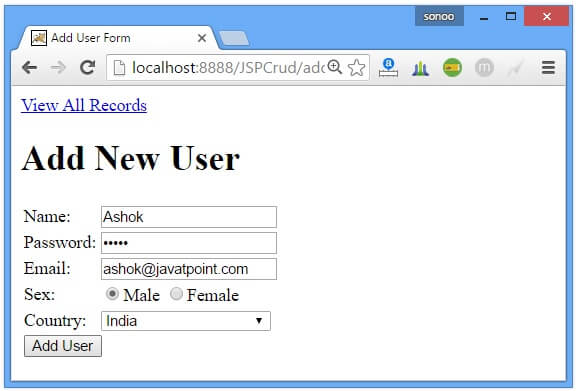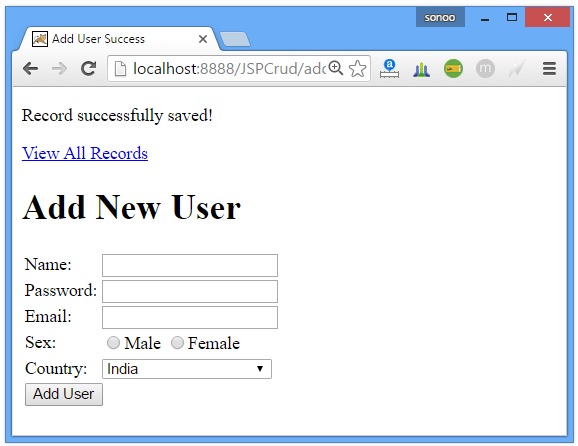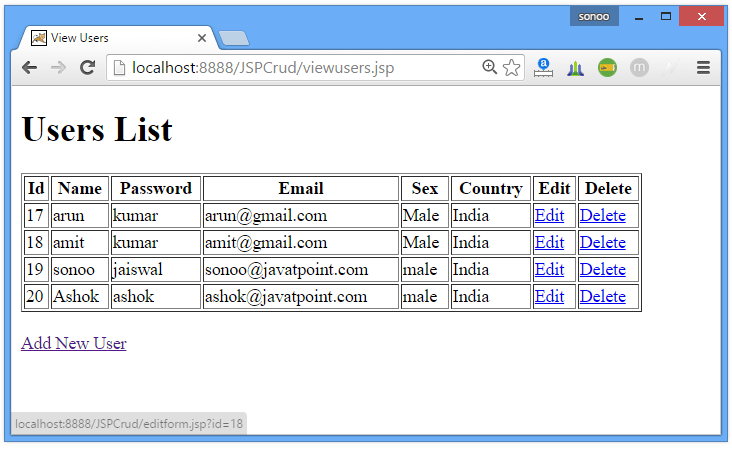In this Java tutorial, we will help you understand the process of writing a basic Java web application that manages a collection of users with basic functions: list, insert, update, delete (or CURD operations - create, update, read and delete). The application looks like this:

You will learn how to build this application using the following technologies:
- Java Server Pages (JSP)
- JSP Standard Tag Library (JSTL)
- Java Database Connectivity (JDBC)
- MySQL database
- Apache Tomcat server
We use Eclipse IDE and Maven to develop projects.
1. Create a MySQL database
To keep it simple, we only have one table. Execute the following MySQL script to create a database named test and a table named register :
CREATE DATABASE `test`;
CREATE TABLE IF NOT EXISTS `user` (
`id` int(10) NOT NULL AUTO_INCREMENT,
`name` varchar(100) NOT NULL,
`password` varchar(100) NOT NULL,
`email` varchar(100) NOT NULL,
`sex` varchar(100) NOT NULL,
`country` varchar(100) NOT NULL,
PRIMARY KEY (`id`)
) ENGINE=InnoDB ;
INSERT INTO `user` (`id`, `name`, `password`, `email`, `sex`, `country`) VALUES
(17, 'arun', 'kumar', '[email protected]', 'Male', 'India'),
(19, 'sonoo', 'jaiswal', '[email protected]', 'male', 'India'),
(20, 'Ashok', 'ashok', '[email protected]', 'male', 'India');
You can use the MySQL command line client or the MySQL Workbench tool to create the database.
2. Use Maven to create an Eclipse project
In the Eclipse IDE, click File > New > Dynamic Web Project to create a new Java Dynamic Web Project. Name the project UserReg:

Remember to select Target runtime as Apache Tomcat v8.0 and Dynamic web module version as 3.1 (this is the Java servlet version).
Click Finish . Then convert this project to a Maven project, right-click the project and select Configure > Convert to Maven Project , as shown below:

Creating a Maven POM file requires entering information, such as group ID, artifact ID, etc. Then add the following dependencies in the pom.xml file:
<project xmlns="http://maven.apache.org/POM/4.0.0"
xmlns:xsi="http://www.w3.org/2001/XMLSchema-instance"
xsi:schemaLocation="http://maven.apache.org/POM/4.0.0 https://maven.apache.org/xsd/maven-4.0.0.xsd">
<modelVersion>4.0.0</modelVersion>
<groupId>UserReg</groupId>
<artifactId>UserReg</artifactId>
<version>0.0.1-SNAPSHOT</version>
<packaging>war</packaging>
<dependencies>
<dependency>
<groupId>javax.servlet</groupId>
<artifactId>javax.servlet-api</artifactId>
<version>3.1.0</version>
<scope>provided</scope>
</dependency>
<dependency>
<groupId>javax.servlet.jsp</groupId>
<artifactId>javax.servlet.jsp-api</artifactId>
<version>2.3.1</version>
<scope>provided</scope>
</dependency>
<dependency>
<groupId>jstl</groupId>
<artifactId>jstl</artifactId>
<version>1.2</version>
</dependency>
<dependency>
<groupId>mysql</groupId>
<artifactId>mysql-connector-java</artifactId>
<version>8.0.28</version>
</dependency>
</dependencies>
<build>
<sourceDirectory>src</sourceDirectory>
<plugins>
<plugin>
<artifactId>maven-compiler-plugin</artifactId>
<version>3.8.1</version>
<configuration>
<source>1.8</source>
<target>1.8</target>
</configuration>
</plugin>
<plugin>
<artifactId>maven-war-plugin</artifactId>
<version>3.2.3</version>
<configuration>
<warSourceDirectory>WebContent</warSourceDirectory>
</configuration>
</plugin>
</plugins>
</build>
</project>As you can see, the dependencies here are for Servlet, JSP, JSTL, and MySQL Connector Java (JDBC driver for MySQL).
3. Write model classes
Next, use the following code to create a Java class named User.java to model the User entity in the database:
package com.javatpoint.bean;
public class User {
private int id;
private String name, password, email, sex, country;
public int getId() {
return id;
}
public void setId(int id) {
this.id = id;
}
public String getName() {
return name;
}
public void setName(String name) {
this.name = name;
}
public String getPassword() {
return password;
}
public void setPassword(String password) {
this.password = password;
}
public String getEmail() {
return email;
}
public void setEmail(String email) {
this.email = email;
}
public String getSex() {
return sex;
}
public void setSex(String sex) {
this.sex = sex;
}
public String getCountry() {
return country;
}
public void setCountry(String country) {
this.country = country;
}
}
As you can see, this class has 6 fields based on the 6 columns in the table book in the database: id, name, password, email, sex and country.
4. Encoding DAO classes
Next, we need to implement a data access layer (DAO) class that provides CRUD (create, read, update, delete) operations for the table user in the database . Here is the complete source code of the UserDAO class:
package com.javatpoint.dao;
import java.sql.*;
import java.util.ArrayList;
import java.util.List;
import com.javatpoint.bean.User;
public class UserDao {
public static Connection getConnection() {
Connection con = null;
try {
Class.forName("com.mysql.cj.jdbc.Driver");
con = DriverManager.getConnection(
"jdbc:mysql://localhost:3306/test?autoReconnect=true&useSSL=false&useUnicode=true&characterEncoding=UTF-8&serverTimezone=Asia/Shanghai",
"root", "root");
} catch (Exception e) {
System.out.println(e);
}
return con;
}
public static int save(User u) {
int status = 0;
try {
Connection con = getConnection();
PreparedStatement ps = con
.prepareStatement("insert into user(name,password,email,sex,country) values(?,?,?,?,?)");
ps.setString(1, u.getName());
ps.setString(2, u.getPassword());
ps.setString(3, u.getEmail());
ps.setString(4, u.getSex());
ps.setString(5, u.getCountry());
status = ps.executeUpdate();
} catch (Exception e) {
System.out.println(e);
}
return status;
}
public static int update(User u) {
int status = 0;
try {
Connection con = getConnection();
PreparedStatement ps = con
.prepareStatement("update user set name=?,password=?,email=?,sex=?,country=? where id=?");
ps.setString(1, u.getName());
ps.setString(2, u.getPassword());
ps.setString(3, u.getEmail());
ps.setString(4, u.getSex());
ps.setString(5, u.getCountry());
ps.setInt(6, u.getId());
status = ps.executeUpdate();
} catch (Exception e) {
System.out.println(e);
}
return status;
}
public static int delete(User u) {
int status = 0;
try {
Connection con = getConnection();
PreparedStatement ps = con.prepareStatement("delete from user where id=?");
ps.setInt(1, u.getId());
status = ps.executeUpdate();
} catch (Exception e) {
System.out.println(e);
}
return status;
}
public static List<User> getAllRecords() {
List<User> list = new ArrayList<User>();
try {
Connection con = getConnection();
PreparedStatement ps = con.prepareStatement("select * from user");
ResultSet rs = ps.executeQuery();
while (rs.next()) {
User u = new User();
u.setId(rs.getInt("id"));
u.setName(rs.getString("name"));
u.setPassword(rs.getString("password"));
u.setEmail(rs.getString("email"));
u.setSex(rs.getString("sex"));
u.setCountry(rs.getString("country"));
list.add(u);
}
} catch (Exception e) {
System.out.println(e);
}
return list;
}
public static User getRecordById(int id) {
User u = null;
try {
Connection con = getConnection();
PreparedStatement ps = con.prepareStatement("select * from user where id=?");
ps.setInt(1, id);
ResultSet rs = ps.executeQuery();
while (rs.next()) {
u = new User();
u.setId(rs.getInt("id"));
u.setName(rs.getString("name"));
u.setPassword(rs.getString("password"));
u.setEmail(rs.getString("email"));
u.setSex(rs.getString("sex"));
u.setCountry(rs.getString("country"));
}
} catch (Exception e) {
System.out.println(e);
}
return u;
}
}
As you can see, the JDBC connection information is injected into this class through its constructor. The following methods are available for CRUD operations:
5. Write JSP pages
Next, create a JSP page to display all books in the database. The following is the code of the jsp page under the WebContent directory in the project :
index.jsp
<%@ page language="java" contentType="text/html; charset=ISO-8859-1"
pageEncoding="ISO-8859-1"%>
<!DOCTYPE html PUBLIC "-//W3C//DTD HTML 4.01 Transitional//EN" "http://www.w3.org/TR/html4/loose.dtd">
<html>
<head>
<meta http-equiv="Content-Type" content="text/html; charset=ISO-8859-1">
<title>Insert title here</title>
</head>
<body>
<a href="adduserform.jsp">Add User</a>
<a href="viewusers.jsp">View Users</a>
</body>
</html>adduserform.jsp
<%@ page language="java" contentType="text/html; charset=ISO-8859-1"
pageEncoding="ISO-8859-1"%>
<!DOCTYPE html>
<html>
<head>
<meta http-equiv="Content-Type" content="text/html; charset=ISO-8859-1">
<title>Add User Form</title>
</head>
<body>
<jsp:include page="userform.html"></jsp:include>
</body>
</html>userform.html
<a href="viewusers.jsp">View All Records</a>
<br />
<h1>Add New User</h1>
<form action="adduser.jsp" method="post">
<table>
<tr>
<td>Name:</td>
<td><input type="text" name="name" /></td>
</tr>
<tr>
<td>Password:</td>
<td><input type="password" name="password" /></td>
</tr>
<tr>
<td>Email:</td>
<td><input type="email" name="email" /></td>
</tr>
<tr>
<td>Sex:</td>
<td><input type="radio" name="sex" value="male" />Male <input
type="radio" name="sex" value="female" />Female</td>
</tr>
<tr>
<td>Country:</td>
<td><select name="country" style="width: 155px">
<option>India</option>
<option>Pakistan</option>
<option>Afghanistan</option>
<option>Berma</option>
<option>Other</option>
</select></td>
</tr>
<tr>
<td colspan="2"><input type="submit" value="Add User" /></td>
</tr>
</table>
</form><%@page import="com.javatpoint.dao.UserDao"%>
<jsp:useBean id="u" class="com.javatpoint.bean.User"></jsp:useBean>
<jsp:setProperty property="*" name="u" />
<%
int i = UserDao.save(u);
if (i > 0) {
response.sendRedirect("adduser-success.jsp");
} else {
response.sendRedirect("adduser-error.jsp");
}
%>adduser-success.jsp
<!DOCTYPE html>
<html>
<head>
<meta http-equiv="Content-Type" content="text/html; charset=ISO-8859-1">
<title>Add User Success</title>
</head>
<body>
<p>Record successfully saved!</p>
<jsp:include page="userform.html"></jsp:include>
</body>
</html>adduser-error.jsp
<!DOCTYPE html>
<html>
<head>
<meta http-equiv="Content-Type" content="text/html; charset=ISO-8859-1">
<title>Add User Success</title>
</head>
<body>
<p>Sorry, an error occured!</p>
<jsp:include page="userform.html"></jsp:include>
</body>
</html>viewusers.jsp
<!DOCTYPE html>
<html>
<head>
<meta http-equiv="Content-Type" content="text/html; charset=ISO-8859-1">
<title>View Users</title>
</head>
<body>
<%@page
import="com.javatpoint.dao.UserDao,com.javatpoint.bean.*,java.util.*"%>
<%@ taglib uri="http://java.sun.com/jsp/jstl/core" prefix="c"%>
<h1>Users List</h1>
<%
List<User> list = UserDao.getAllRecords();
request.setAttribute("list", list);
%>
<table border="1" width="90%">
<tr>
<th>Id</th>
<th>Name</th>
<th>Password</th>
<th>Email</th>
<th>Sex</th>
<th>Country</th>
<th>Edit</th>
<th>Delete</th>
</tr>
<c:forEach items="${list}" var="u">
<tr>
<td>${u.getId()}</td>
<td>${u.getName()}</td>
<td>${u.getPassword()}</td>
<td>${u.getEmail()}</td>
<td>${u.getSex()}</td>
<td>${u.getCountry()}</td>
<td><a href="editform.jsp?id=${u.getId()}">Edit</a></td>
<td><a href="deleteuser.jsp?id=${u.getId()}">Delete</a></td>
</tr>
</c:forEach>
</table>
<br />
<a href="adduserform.jsp">Add New User</a>
</body>
</html>editform.jsp
<!DOCTYPE html>
<html>
<head>
<meta http-equiv="Content-Type" content="text/html; charset=ISO-8859-1">
<title>Edit Form</title>
</head>
<body>
<%@page import="com.javatpoint.dao.UserDao,com.javatpoint.bean.User"%>
<%
String id = request.getParameter("id");
User u = UserDao.getRecordById(Integer.parseInt(id));
%>
<h1>Edit Form</h1>
<form action="edituser.jsp" method="post">
<input type="hidden" name="id" value="<%=u.getId()%>" />
<table>
<tr>
<td>Name:</td>
<td><input type="text" name="name" value="<%=u.getName()%>" /></td>
</tr>
<tr>
<td>Password:</td>
<td><input type="password" name="password"
value="<%=u.getPassword()%>" /></td>
</tr>
<tr>
<td>Email:</td>
<td><input type="email" name="email" value="<%=u.getEmail()%>" /></td>
</tr>
<tr>
<td>Sex:</td>
<td><input type="radio" name="sex" value="male" />Male <input
type="radio" name="sex" value="female" />Female</td>
</tr>
<tr>
<td>Country:</td>
<td><select name="country">
<option>India</option>
<option>Pakistan</option>
<option>Afghanistan</option>
<option>Berma</option>
<option>Other</option>
</select></td>
</tr>
<tr>
<td colspan="2"><input type="submit" value="Edit User" /></td>
</tr>
</table>
</form>
</body>
</html>edituser.jsp
<%@page import="com.javatpoint.dao.UserDao"%>
<jsp:useBean id="u" class="com.javatpoint.bean.User"></jsp:useBean>
<jsp:setProperty property="*" name="u" />
<%
int i = UserDao.update(u);
response.sendRedirect("viewusers.jsp");
%>deleteuser.jsp
<%@page import="com.javatpoint.dao.UserDao"%>
<jsp:useBean id="u" class="com.javatpoint.bean.User"></jsp:useBean>
<jsp:setProperty property="*" name="u" />
<%
UserDao.delete(u);
response.sendRedirect("viewusers.jsp");
%>6. Deploy and test the application
At this point we have completed the project code. It's time to deploy and test the application to see how it works. If you don't know how to add Apache Tomcat server in Eclipse, follow this tutorial.
Type the following URL in your web browser to access the UserReg application:
http://localhost:8080/UserReg
output




